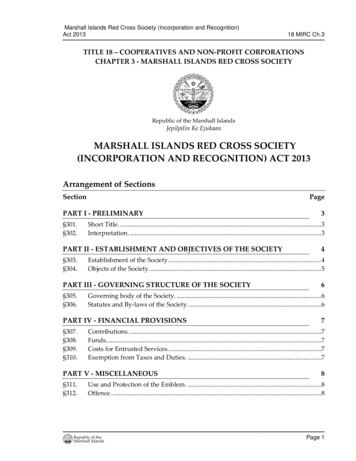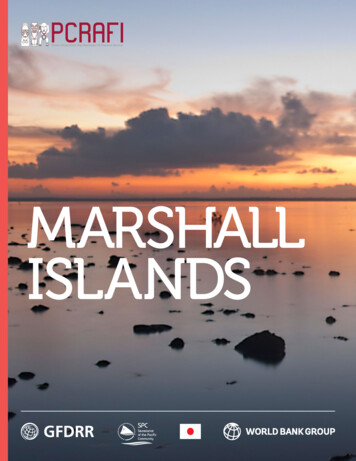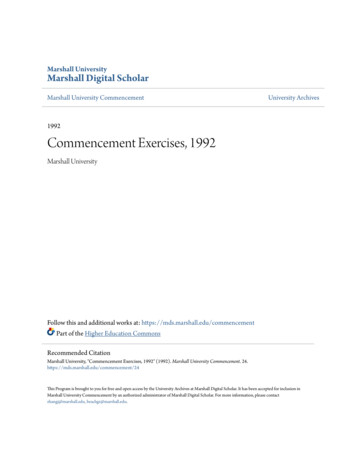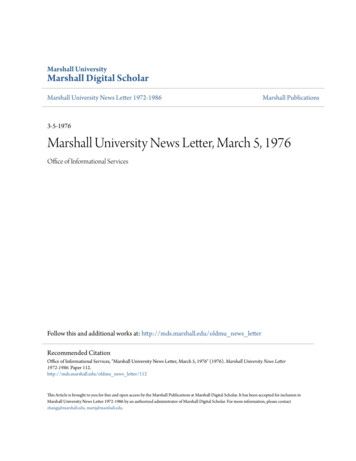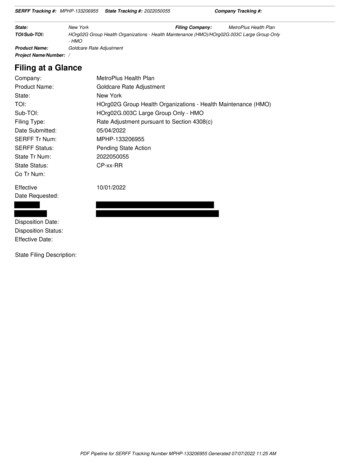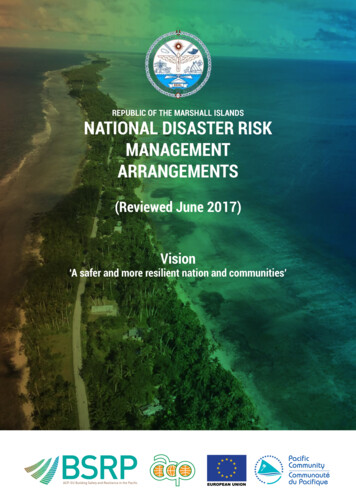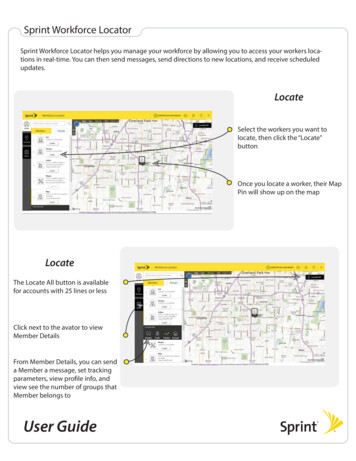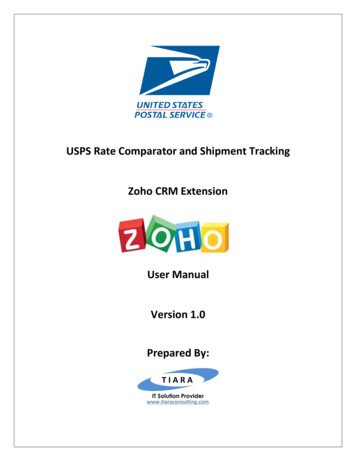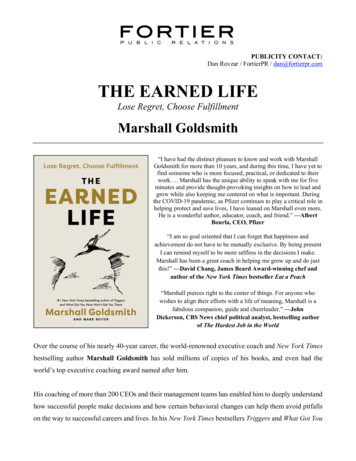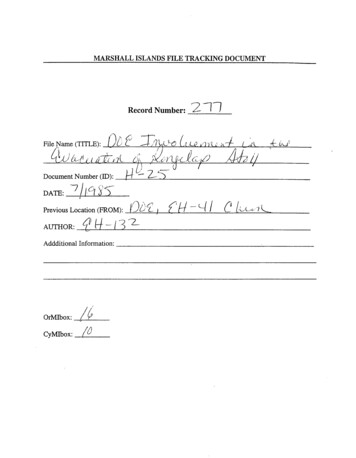
Transcription
MARSHALL ISLANDS FILE TRACKING DOCUMENTRecord Number:Document Number (ID):Previous Location (FROM):AUTHOR:cf p’2qAddditional Information:COrMIbox: /I pCyMrbox: fC!2“1‘7
Departmentoi Energyl?EPLY i(SAN0FSUBJECT:TO:EH-132Department of EnergyRongelap Atoll(DOE) Involvement in the Evacuation ofEdward J. Vallario, EH-1329.: q-‘*acIJlti n of Rongelap Atoll appears to be a totallysenseless action unless the role of the Department of EnergyI in this decision is understood. DOE's involvement couldI subject this Agency to se,v.ere criticism both nationally andi interca i0caU.y.rOn I-lay21, 1985, the first of about 300 people left RongelapAtoll claiming their atoll was not a safe place to live. Thepopulation was transported to Kwajaleiu Atoll on theGreenpeace Ship Rainbow Warrior, the ship that was sunk in NewZealand about a week ago. The Rongelap people have beendisillusioned by what they perceive as contradictory advicefrom DOE on radiation protection, by monitoring results from aDOE contractor indicating that whole body exposures haveincreased at Rongelap Atoll (in.a related finding, exposuresalso increased at Enewetak Atoll), by a high exposureprediction in a Marshallese/English booklet provided by DOE,and by DOE's failure to provide:answers to.questions on theirWhile there weretotal radiation exposure experience.undoubtedly other political and legal forces at work, the sumtotal of DOE's failures is a substantial indictment. The DOEunnecessarily gave the Rongelap people radiologicaljustification to support their leaving Rongelap.After almost 10 years of internal strife over who would managethe programs in the Marshalls, these responsibilities werereassigned from the Office of Environmental Protection,Safety, and Emergency Preparedness (EP) to the AssistantSecretary-of Defense Programs (DP), and more specifically Othe Deputy for Pacific Operations (DPO) of the NevadaOperations Office (NV) (see Attachments 1 and 2).The complaints about contradictory advice appear to refer toadvice presented by the DPO at a meeting at Majuro Atoll iaDecember 1982. This advice was confusing and non-specific*The Rongelap people were told that they should make their ownThey were also told thatjudgments on radiation protection.
I.-,2they could eat food that had been restricted for many years(see Attachments 3 and 4). To support these judgments,information on radiation protection fundamentals was alsoprovided in a Marshall&e/Englishbooklet with the intentionthat the people could make educated decisions (see Attachment5). Risk estimates, rather than radiation standards that were&ortantin the past, would be used for such judgments,Whole body exposures on Rongelap Atollmeasured by BrookhavenNational Laboratory (BNL) increased significantly during 1982 andwere still elevated in 1983. The relaxing of a restriction oncfcer -ain food from more contaminatedU3Iislands at Rongelapappears to be a contributing factor.In the past, thisrestriction was stated clearly as a prohibition (seeAttachments 3 and 6).The high exposure.prediction for Rongelap Island residents of40a mRem/yr in the Harshallese/English booklet (see page 39 ofAttachment 51, appears to be an erroneous value not supported bywhole-body monitoring. Such a high chronic exposure level wouldnot be acceptable. The whole-body measurements support an\exposure less than 100 mRem/yr, provided the food restrictionremains effective.This latter exposure is within currentTo my knowledge, this error has never been correctedstandards.Attachment 1 contains acute and chronic exposure estimates andAttachment g contains relevant radiation standards.Questions about past radiation exposures on Rongelap haveremained unanswered for more than 2 years (see Attachment 1).Though not requested in writing, it is reasonable to assumethe Rongelapese need a discussion of:1.The possibility of additionaldelayed health effects foracute exposures received in 1954.2.The additional chronic exposures received since 1957 for thehighly exposed individuals.3.The chronic exposures since 1957 for those not in the high.exposure group.4.A comparison of exposures, past and future, with radiationprotection standards.Medical followup and advice has been very good for theRongelapese, but not providing them information on their totalradiation exposure condition, information that is available,amounts to a coverup.The questions the Marshallese have raised.
3&out radiological conditions in their atolls have not beenanswered satisfactorily by DOE's Marshallese/Enqlish bookletthat evaluated radiological conditions in the Marshalls interms of risk and cance r fatalities instead of using radiationstandards.The Marshallese, to my knowledge, have neverargued against use of standards or complained that they werenot applicable.This booklet may be a factor of confusionrather than education for the Marshallese.The full dimension of the technical aspects of this problem inthe Marshalls and the reasons for DOE's loss of credibilitywith the Rongelapese, are not well known within DOE.Dissatisfaction with the advice they have received reachedserious proportions in April 1983 when a party of DOE visitorswere interrupted in a meeting with the people on Rongelap byan irate citizen and had to leave the island. The meeting onRonqelap was never resumed and the people's anger and mistrust(of UO2) has been-allowed to fester.Many of us who have worked in the Marshalls have beenfrustrated by the burdensome dietary restrictions, and we haveseen the hardships caused by the loss of use of falloutcontaminated islands. All of this is being imposed byapplication of radiation protection standards mandated byWashington bureaucrats.Right or wrong, I.have argued thatexposures not found acceptable for the U.S. population arealso not acceptable in the Marshalls, and that radiologicalcriteria should be the same from atoll to atoll. This, ofcourse, is not compatible with the idea that the population ofShort of actingeach atoll should make its own judgment.orhavingtheDeparmentof Interioragainst Federal policies,(DOI) mount a successful effort to get an exemption from thesepolicies, the DOE appears to have no valid alternative but tocontinue to apply current radiation standards in theMarshalls.Turning radiological judgments over to the peopleThis appears to have been awas a drastic unilateral action.profoundly disturbing experience for some Marshallese and anaction that undermined confidence in DOE and in the UnitedThe new advice that was obviously intendedStates Government.The Rongelap peopleto give freedom of choice has backfired.foliowed-the advice they were given, made the judgment not t0accept the risk, and left their atoll.
4Knat has been written about the Majuro meeting (who said whatand why) is not so important as what the Marshallese heard andcomprehended.The transcript clearly indicates that the DOEspokesman's answers to questions were not compatible with pastDOE advice and that theMarshalleserecognized this andobjected (see Pages 49 and 50, December 9, Attachment 3).Ireported this problem to DOE staff and to management ofOperational Safety--nothing happened, and the Rongelapese haveunderscored this with their rejection of DOE visitors and withtheir later evacuation.Still nothing was done to correct theerrant advice and to respond to their questions. Now "U.S.government officials" are criticizing the evacuation and arequoted in the press as stating unequivocally that Rongelap is.safe, a question the DPO was unwilling to agree to in Majuro(see Attachment 2, December 9, Page 28, and Attachment 2).Even though DOE'6 credibility with the Rongelap people may bezero, and whether the compact is approved or not, I ruggestDOE has hn obligat'ionto correct ObViOU6 numerical error6 andto clarify its radiation protection policy in the Marshalls.fr the past that policy was to evaluate tection6tandard6,tothat the DO1 is the agency responsible for healthand safety in the Marshalls, and to look to DO1 for anydecisions related to health and safety in the Marshalls, andfor communication of such decisions to the Marshallese. DOElooks to the Environmental Protection Agency (EPA) and to DOI,not to the Marshallese, for decision6 on radiological issuesi (see Attachment 10).I have identifiedalso contributingprograms:the problem6 in the Marshall6 but there arefactors within DOE in the management of1.Mo approved program plan has ever been i66Ued for DOE'6radiological protection effort6 in the Marshalls.2.Coordination of radiological protection issues withHeadquarters' safety staff is almost non-existent.3.Less than adequate utilization4.No liaison vith EPA since 1982.5.No independent.overview.of DOE technical resources*I
5Not to cite a lot of problems without any suggestions, Irecommend that a white paper be developed that clarifies DOE'spositionon radiationMarahalls along withprotectionpolicy as applied to theanswersto the questions on the totalA good source ofexperience on Rongelap.-radiation exposureradiological data and advice on these exposures and theirimplications is available at Brookhaven National Laboratory(see Attachment 11). Translation into Marshallese would beneeded, the Environmental Protection Agency should beinformed, and the paper provided to the Marshallese throughDOI.I further recommend that there is a valuable lesson in thecreation of this situation that needs to be told. Regardlessof interests that were served, and certainly not those of theMarshallese, from a health physics viewpoint, transfer of aunique radiological safety program to DP/NV, a program thatrequired a high degree of coordination and cooperation betweenDOE, DOX, and EPA at,the Washington level, was a mistake.DP's interest in the program appears to have been primarilythe altruistic interests of one person who wanted to changeradiological rules used in the Marshalls, rules that werecausing hardships through loss of use of contaminated land.HP's ignoble interest in transferring the program to DP wasapparently to get rid of a hot potato, and had nothing to dowith Safeguard C. The result is a new low in the annals ofradiation protection standards implemention that should serveas a warning to those who follow narrow self-servinginterests. LK1if&JMcCrawLo3Health PhysicsRadiological Controls DivisionOffice of Nuclear Safety.Attachment
imd.p. *---,. . . . .i. 7 *;.:%. .- 3’ .-., .i. .-:r:.‘:“.‘,.C‘.--. ;z.*.’2‘.Q.-.-:.a-fI-.‘-- . .fL/I’r; *.Y *.I.’: ,\q.-.1. -;.;- :.I:.-.:. .:-. .-.,.-.s.: .-2.-.-;.;.v-.;.’.C- -,;.-. .a:.-.- -,. .- .
-D,‘.Tt:CP-Zt;.t’i-mm--.r::.‘ rrisljcs 3j3-Sf;f3:S/t3!?2. . .
nirtrltutio7:.lthe&ctttarySeCtetaty1::; DeputyUnder Secretarylet:.,.‘. ; 2;:;;,M,l.:-.-.-. . . ;*.‘ .::.- B-. - “ .,:. i.” : .: -. .,; . .*.-.;T. . .-.i-.Ll(.). . . .:,;4’
NOTE TO:.- FROM:--SUBJECT:(Signed)*ma,s F. cornw*ufor- John E. Rudolpha.General HoovemStatus of Marshall Islands Program TransferHr. Roser, Assistant Secretary for Defense Programs (DP), Mr. Trivelpiece,Assistant Secretary for Energy Research (ER), and Mr. Vaughn, AssistantSecretary for Environmental Protection, Safety, and fiergency Preparednes's(EP) met Nay 13, 1982, to discuss the transfer of the Marshall Islandspmgraxts frcm EP to DP.o The ER position is that they do not want to manage the programs butwould be interested in contributing expertise and some funding.o Mr. Vaughn sees EP as an oversight office and did not have a preparedposition with regard to the Marshall Islands.o DP considers the programs vital to the U.S. Govemmt.It is Mr. Roser's opinion that over the years the programs have beenpoorly managed by EP. If DP gets the programs, a Headquarters taskforce will be imediately established (with representatives fromEP and ER) to detemine future program policy and direction.Mr. Vaughn will have further discussions with his staff this week inorder to develop an EP position. The action memorandum is still inVaughn's office and once he has staff discussions, he will eitherfomrard the memorandum to the Secretary or have further discussionswith DP, We will keep you ribution::Addresseelb::: MR Filelbcc: MA/PS/Chronlbcc: MA/PS/Retainlbcc: R. Ray, NV1bee: A. B. Siebert, DP-3.1lbcc: B. Burr, DP-3.1B. A. Cooper, DP-221:G. C. Facer, DP-226K:::ac:7. McGraw, EP-32w. . . . .mnuw.,. .mwll?G Sib,.m1uLt,.OAWnrt. . . .vnrz:. . . .OIrc
Attac.hent 3TRAh'SCRIP77ON OF MEETIrlG BETWEEN DDE REPRESENTATIVEAND GOVERNMENT @FFICIALS OF THE REPUBLIC OF THEMARSHALL ISLANDS AT MAJURODECEMBER 8 AND 9, 1982Note:The attachedpageswereselectedfroma 99 pegetranscriptonof a taperecordingprepared’by tory.
.DecemberMale Person:Buck:8,1982How much more have we got to cover?We ate ready to s.tart Chapter 5 and Chapter 6 before the maps.Weweren't going to go on to each Individual map.[Alice continuedpresentationin Marshallese.]TAPE 3, SIDE 2Harshallese:about cancer.I am asking about cancer and birth defects, but primarilyHow Rlany.cancers have appeared in the Rongelap populationsince the time of the teiting of the bombs?Bair:I don't know.Harshallese:Bair:So, whatisthe meaning of O.l?That means that if people, that if people receiving radiation duringthe next 30 years, not in the past, but during the next 30 years, wewould., if they receive radiation on Rongelap for the next 30 years, wewould not really expect any cancers to be caused by the radiation. But weare not saying there isn't a chance that there might be one.The risk is.I don't know how to.Bair:One possible way; if there uere 10 times as many people on Rongelap,If there were 2,000 people today and they 14vtd and had children for thenext 30 years, then theecaused by radiation.flarshallese:might be one person (receiving) having cancerThere might be.If your figures here reflected the period from the timethat the bombs were tested for a 30 year period,,,would YOU be able to makean estimate In figures that way?27
. -a.,Bair:I knew the radiation doses, if I knew how much radiation peopleIfreceiwd,yes.But I don't know how much radiation people received.Marshal'lese: Could you refer to the report of all the teams that have comeCouldand visited us and taken samples and examined us and gathered data?you not look at that?We have been visited.Bair-: It might be possible to estimate how many but it would be verydifficult because you also have to know how much food people ate duringthat period of time.Cowan:YouI have no way of knowing.make assumptions based upon MLSC and the Battelle Northwestdiet tn make these brbjections.Couldn't you use the same diet as thebasis to make projections based on data (unclear)?It is not a Battelle diet it is Brookhaven diet.Bait:Cowan:mkeOkay, whatever diet, you had to use some basis of food intake tothese projections?Bait:You could do that.Harsha.llese from Ronae?ao:? think that we have had a lots of datagathered in our population at Rongelap and if you went to the labs in.Seattlc and looked into this, probably that could be determined.Bait:I think Brookhavenis making a determination on the thyroid; theradiation, the amount of radiation t-he thyroid(s) of the peopkreceived.haveI don't think-their report is finished yet.?larshallese:I'm just wondering.As we've already asked, seriously 1wishthat you could tell how many people might have died from cancer from thetime Of the testing until now rather than this figure which projects intothe future.
.Ray:I think the answer, an answer to that question is, yes, a study couldOur data and amount of information that we would have about thosebe done.earlier days would not be-nearly as complete as what we havenow1978 time.Nevertheless some estimate could be made.would only be able to indicate the likelihood that, offrom theThat estimate stillthosepeople whohave died of radiation relateable diseases, some number might beattributable to the radiation.Marshallese:I feel that this whole book is affecting or applicable to thecoming generation, the young children, because in the next 30 years my agegroup and older will be gone.So this isn't reallyareport for us. it isAnd, also, that I detect that themaybe a report for them ra'ther than us.results of the infoimation in this book is reporting a time that has muchless damaging effects, in fact, it almost looks rather clean in comparisonto the number of years which are not included in this book.And, so frommy point of view, I don't know that this is. I would nuch prefer a bookthat gave the entire picture rather than half the picture and thehalf at that.betterIn fact I hesitate to go forward and say much about thisbook.&:Well, I would just like to say again, the purpose of this book, thatpurpose was to provide a basis for informed decisions about futureThat's the sole purpose of the sumey,to determine whether thererecormnendations made for future actions that would protect peopleevent that we found radiation levels that were of concern.commitment that we made some time ago.forIn theThat was thethis particlrlar purpose.is not the whole story, you are absolutely right.reports publqshed that deal with the past.actions.should bethis(and) There are manyThose are available and as Ihave said earlier, if there are specific questions 1 am sure that we wouldbe willing to help with converting those, translating those, fnto yourlanguage so that they are understandable.survey.It was to guide future actions.That wasn't the purpose of this
Ray:He WE! asking about Jorkan.Do you have It?Ye, no we don'tbaveRobison:it.' (background discussion) *We didn'tcalculate the dose for that.Buck:Jotian is down from Melu, two islands.Robison:Tch,the only thing.Let me look.We didn't calculate a dosefor that island because that was never given to us as one of the residenceislands.I am trying to find here.if we even have. I don't evenSohave that name.(Background discussion:No, you didn't do that one.did tlelu.) Ye have no dati on that one.YouExcept we have the external gamMdata, which I can ehsily tell, it's it's like Melu, but I would have tolook at that data first.Marshallese:The northern part of Rongelap is the place that they gathera lot of their protein sources, you knw,say what?)(Alice:meats from animals.YouEven though they don't live there theyPigs, crabs, birds.like to go and gather these kinds of things from there.Buck:Okay, let's have the slides that show these comparisons.that's sort of a good sumnary.And maybeI’m not sure we were going to pass thesepapers out.[Alice continued presentation in Matshallese.]Harshallese:Do you have a safetystandard come with hferenceBair:standardthen fa these?to these tigures?One comparison is that people in the U.S. whofrom background would get about 2500 in 30 years.For any part of the body?33justget radiationWhich is the number1right there.Buck:Wht?re does the
-a--DecemberMarshalfese:9,1982Now I would llke to also,asked yesterday.then,repeat the question thatIDoes this indicate that these atolls are all within safeV'standards for people to live and eat the food that is grown on thoseatolls?RaJ:We do not normally try to characterize a location as safe or not.Itis a matter of amount of risk and the amount of risk is set forth here.Marshallese:It seemed like yesterday the statement was said that actuallythe amount of radiation in the Marshalls is similar to that of other placesin the world.And so that would indicate that, well people live fairlyfreely in their places., other places in the world, and if we are lfke them,that it seems to me.that we ought to have that same desctiption of ourconditions, that it is safe to be there.actually we shouldn't eat certain things.talk.And yet, no, we hear thatso you seem to be talking doubleIt seems like you say in one statement, we are like other places,and in another statement you are saying, no it is different.Ra v:Uhat we are saying is that with the exception of BiLini Island, the,all of the locations we have studied, Bikini Island rather than atoll, allof the locations we have studied would meet the standards, stay within thestandards living in those places.However, there are places where choicescan be made to keep the radiation exposures nf people louer, even, by, forexample, restricting the intakeRongelap.themof food from the northernislandsofThat seems a smart thing to do if there is an alternative andis.Senator John:Thank you for your reply and it seems like now that's alittle different from what I understood you to say yesterday.It sCe!%like yesterday you were saying everything was fine and dandy and nOW YOU atleast say, separated Bikini island out.I would like to now ask aboutEnewetak.I would like to ask about that if you dre going to talk aboutEnewetak.And then I wouldliketo be heard again after28he's finished.1/
. - -Ray:All right, Senator.Senator John:I was inte rested to hear you say that the island ofis different from all of the other islands in these atolls.BikiniBut now I wantto ask pointedly, face to face, how about Runit and Enjebi?Ray:You are correct, Senator, that I should have mentioned Runit becauseit is a special case.I was thinking of it as an island that is not nowand has not been intended to be, for some years, a residence island.certainly is an exception,ItIt's not quite the same situation as Bikini butall of us agree that residence on Runit would not be advisable.As toEnjebi, Enjebi is, has been reported to the people of Enewetak,and the dose expectations for living onfalls within this same range, the rangeand the,Enjebi have been reported. Itof numbers that we're talking aboutBill you can help me with what they are.here.Robison:It is very near the guidelines.It is right around theguidelines for that island.Q:Enjebi is very close to the guideline, very close to the standards.Close to the standard?Buck:&:Close to the guidelines.Senator John:Okay, mll,then. since I have hei&I would really like a clarification on Enjtbiwhat ycu have just%aid.know that there has been plenty of-breadfruitI understand, tha&planted for experimentation,for observation at Enjebi and we are in a situation now where we'reUe have,and there are plenty of ripe breadfruit at Enjebi.your recorrmendation, permissionhungry.Would I haveto notify my people that they can eatbreadfruit from Enjebi, that breadfruitwhich is grown there andthatin a test situation but is ripe and ready to eat and we need it?out of food at other places, so can we go to Enjebi and hawestthere?IwasYe arebreadfruit
--m-mRay:Well, I think the answer is clearly, yes you can.But if there aresubstitute locations, substitute sources which would have lower radiationlevels we would recomnen that those be used.Senator John:Uell, thanks, I'm, I'm glad to hear that, that we canthose breadfruit from Enjebi,But it seems funny that you addusea 'but'right away as soon as you say that, when in actuality we've had a storm hitus and we only have very young trees planted on other islands in the atolland, even though they weren't full grown, they had produced somebreadfruit,sort of out on their trunks almost, not even on the ends of thelimbs where they usual1.y appear.blown away.We really'can't harvest breadfruit from other islands, butthey are at Enjebi.have a choice.some other.there, so,Ray:We got good breadfruit at Enjebi and, so, we don'tYou say if we had that choice you would recommend usingWell, that choice isn't there, but we do have those breadfruitI'm glad to hear, then, that you say we can use those.I would like Bill Robison to cementThat's correct.Robison:But they were there, but these have beenon that.Yes, Senator, we planted the breadfruit and pandanas and coconuttrees on Enjebi, as you know, as part of our program in order to betterevaluate Enjebi Island.As pu.knoutie*wmeno foods available for USto directly measure and we had to predict what we thought the concentrationwould be in food products at Enjebi by knowing what was in the soil.planted the crops, sothat we would have samples to directly measure ati,therefore, we could makeEnjebi;50 wea nurch more precise estimate of the doses onAnd therefore, we need those for samples, and it takes quite anumber of breadfruit and quite a number of pandanas fruit and a quite anumber of coconut in order for us to be able to make the analysis we need.So we planted those for a purpose and we do need them for a purpose.not, we do not need them all but we do need.1Me do
Buck for the Marshallese:Oh, I uas just going to say, the meaning of yourreply, is leave them for us.Don't use them because we need them.Ray:Well, I'm just saying that we do need a certain number of breadfruitand pandanas in order to, to make better evaluations of Enjebi Island andif they are all gone then we can't do that.Senator John:I wouldSo we need some of them.like there to be a supplement report or additionalinformation given than what is in the book and on this, this matter.in each jrland or atollWhereis it best to harvest or have food grown and whatare the amounts of certainfoods that would be advisable for us to feel.free in eating as opposbd.to.otherthat, because that'infonnationamounts.Are there some guidelines lfkeisn't given here and it seems very importantfor us to know?Ray:And that is precisely,that is precisely one of the reasons that BillRobison needs to continue the experimentationexclusively applicable to Enjebi.on Enjebi.That is notIt's learning what occurs in an islandfor application to other locations. as well.Senator John:Well, thank you for your reply.I just am still kind ofmarveling at the fact that you have quite extensive data 1n this tifrom atoll to atoll but I really don't see any concrete reromnendationsthat you have made regarding people's diet.important for us to know.Robison:And it seems like that isvmyHow mtch breadfnrit, how much pandanas?Well, I think againI can repeat uhat was said earlier with theexclusion of Bikini and the northern end of Rongelap there is no need tiworry, 1 mean you can eat breadfruit and pandanas and coconut from any Ofthe islands in any quantity from the other atolls.The doses we predictfrom that are very low and like we said are no ditferent than, thanexposures that other people get throughout the world.Warshallese:Your number 4 on this map, .it seems like yesterday YOUsaid everywhere is fine, permissiblefor people to live and take their food
-. .%from everyplace, any place on the map and of course non you are sayingwell the northern part of Rongelap would be treated differently and Bikiniisland itself.Uell, ne see other fours around and so I am confused by theinformation you are telli:g me right now.from what you said.It seems like it has changedYesterday, it seems like it was fine anywhere, now youare saying, well, anywhere but those places and yet that doesn't correspondto what the map reflects.What does 4 here mean?Is four all tight or notall right?Robison:Well, we didn't say yesterday that it was okay to use foods fromeverywhere.That clas not what was said.I am saying now that except forthe northern part of Ron e.lap and Bikini, that the other atolls that weepart of the survey,'they'refine.I mean you can tat all the breadfruitand pandanas that you want from those places and the doses we estimate arevery low.The "four" numbers you see, once again remember, Phil, thatdesignates a range and it doesn't mean that an island that has a 4 isnecessarily the exact same number.It just means that they are in a rangesomewhere and they can be different.Senator John:I have futiher questions, ‘later on, but I will defer MUothers and I am just concerned though, too.toI feel I am a bit confused andtherefore 1 am fairly certain that people on the outer islands will btperhaps as confused as I Am and, even more, with this kind of explanattfonthat we are heating,Buck:Ray:There is 6 hand over there.I ianted,if f may, to go back to Senator Ishmael John's, questionabout Enjebi and I want to leave that.Recognizing that you do have aproblem because of the recent storm, and because things are not yetproducing on the southern islands, we would not recommend against yoursupplementing the diet on the southern islands by borne foods taken fromEnjebi.On the basis of any radiation concern we would not recommend
aqaimtMthat, or any health concern.But we would plead with you, to notdestroy the 8 years of work that has gone intotryingto understand what'sgoing on there by, by taking all of the crops off Enjebi.Senator John:?4ay I replyUell,to that?.I just want to remind youthen,that the first part of this year, I believe, DOE sent their ship up, and wehad a body count of our population or, you know certain of our people.Andsome people who had not showed contamination before, or at least a certainamount, that had risen and so we were asked, those people were asked, 'Wellhave you been drinking coconuts from Enjebi?""Yah!""Have you eaten somebreadfruit from Enjebi?" . "Well yes.""Well then that is why your bodycount has risen." And so -look, .we have already been told that and now youare saying that we ran go do that.And yet that, it is obvious that we aregonna, our body counts are going to rise, because if we go and do that.Ray:That is absolutely correct.It will rise, you would expect that, andthat is one of the reasons we have the whole body counting program, inorder that we can anticipate and see before that rise becomes a matter ofconcern.ohlife.All of us have a fluctuation in our whole body count throughoutThis is occurring all thetime.I would compare it, Senator,mith your doctor who may put you on the scale and weigh you periodically.If he has put you on a diet, I am not speaking of you of course, this wouldnot apply to you, but if your doctor should think that someone was gainingtoo narch weight, he mig
A comparison of exposures, past and future, with radiation . met Nay 13, 1982, to discuss the transfer of the Marshall Islands pmgraxts frcm EP to DP. o The ER position is that they do not want to manage the programs but . poorly managed by EP. If DP gets the programs, a Headquarters task
